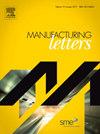使用具有独立控制阳极的多阳极系统电化学增材制造互嵌结构
IF 1.9
Q3 ENGINEERING, MANUFACTURING
引用次数: 0
摘要
交织部件广泛应用于各种工程领域。重叠、交织的结构给使用传统增材制造技术进行制造带来了挑战,尤其是在小尺寸范围内。电化学增材制造(ECAM)已被证明能成功制造出小尺寸的悬挂部件,而无需依赖支撑结构。本研究通过使用多阳极电化学快速成型制造系统,将电化学快速成型制造技术的功能扩展到制造相互咬合的零件。ECAM 工艺由一个工具头操作,工具头由多个阳极组成,这些阳极由内部制造的多电位静电系统上的单通道独立控制。每个阳极都可通过控制定制电子元件的预定义编码模式独立切换到活动(阳极)或非活动(开路)模式。当每个工具处于阳极模式时,其对整个沉积过程的电流贡献也会被独立跟踪。每个独立的工具都可以沉积从自身或相邻工具沉积区域延伸出来的材料。整个多头工具由一个三轴平移系统控制移动。利用该系统可以制造出与实际工程应用相关的互咬梳几何形状。该几何图形采用逐体素并行工具路径,在工具头的每个位置都具有特征电极激活模式。研究发现,与采用 10 分钟时间限制的控制系统相比,无时间限制的纯闭环控制所生成的几何体质量更好。这项研究从总体上展示了多阳极系统的工作原理及其制造部件相互咬合结构的能力。因此,本研究推进了 ECAM 作为一种有价值的增材制造工艺的能力,它可以为相关工程应用制造各种具有挑战性的零件。本文章由计算机程序翻译,如有差异,请以英文原文为准。
Electrochemical additive manufacturing of interdigitated structures using a multi-anode system with independently-controlled anodes
Interdigitated parts are used across a multitude of engineering applications. The overlapping, intertwined structures pose a challenge for fabrication using conventional additive manufacturing techniques, especially at small size scales. Electrochemical additive manufacturing (ECAM) has been shown to successfully create overhanging parts at the small scale without reliance on support structures. This study extends the ECAM capabilities into demonstration of the fabrication of interdigitated parts by the use of a multi-anode electrochemical additive manufacturing system. The ECAM process is operated by a tool head consisting of multiple anodes independently controlled by individual channels on an in-house-built multipotentiostatic system. Each anode is independently switched into active (anodic) or inactive (open-circuit) mode using a predefined, coded pattern controlling the custom electronics. While each tool is in anodic mode, its current contribution into the overall deposition process is tracked independently as well. Each independent tool can deposit material extending from regions deposited by itself or neighboring tools. The entire multi-head tool is controllably moved by a 3-axis translation system. An interdigitated comb geometry relevant to practical engineering applications is fabricated using this system. This geometry is built using a parallelized voxel-by-voxel tool path with characteristic electrode activation patterns at each position of the tool head. It was found that a purely closed-loop control with no time limit yielded a qualitatively better geometry than a control system with a 10-minute time limit applied. This study overall demonstrates the working principle of a multi-anode system and its ability to fabricate parts interdigitated structures. This study therefore advances the capabilities of ECAM as a valuable additive manufacturing process that can fabricate a variety of challenging parts for relevant engineering applications.
求助全文
通过发布文献求助,成功后即可免费获取论文全文。
去求助
来源期刊

Manufacturing Letters
Engineering-Industrial and Manufacturing Engineering
CiteScore
4.20
自引率
5.10%
发文量
192
审稿时长
60 days
 求助内容:
求助内容: 应助结果提醒方式:
应助结果提醒方式:


